 Some information about Cambridge colleges
Some information about Cambridge colleges


 Some information about Cambridge colleges
Some information about Cambridge colleges

Admission to the University of Cambridge is via the colleges. Although the university was founded in 1209, and the first college not until 1284, the oldest buildings in the university belong to the colleges. The colleges are listed below in order of their date of foundation. The coat of arms were mostly taken from the railway station. There is a photo of the older colleges (click on it for a larger version). There are also the college scarf colours and blade colours used by the colleges. There is an explanation of the Bumps, the college rowing races, here.
This page is not a walk. The gates walk takes you around the gates and gatehouses of the older colleges. Some of the old buildings and other buildings belong to the colleges. Please remember that if you wish to visit the colleges (as opposed to looking at their gates from outside), some colleges charge for entrance, and all may close around examination time. The colleges all have a porters lodge at their entrance. The porters will tell you if the college is open, and what you are allowed to see.
| Coat of arms | College information | Scarf colours | Blade colours | Photo | Previously | Founded by |
|---|---|---|---|---|---|---|
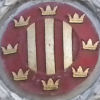 |
Peterhouse Trumpington Street founded 1284 website |
 |  |
 | part of St Johns Hospital | Hugh de Balsham, Bishop of Ely |
 |
Clare College Trinity Lane founded 1326 website |
 |  |
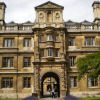 | University Hall Clare Hall | Elizabeth de Clare, grand-daughter of Edward I |
1346-1353 Black Death | ||||||
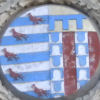 |
Pembroke College Trumpington Street founded 1347 website |
 |  |
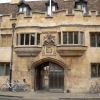 | Hall of Valence Mary Pembroke Hall | Marie de St Pol, Countess of Pembroke |
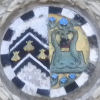 |
Gonville and Caius College Trinity Street founded 1348 website |
 |  |
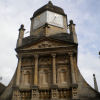 | Gonville Hall | Edmund Gonville, and John Caius (physician to Edward VI and Mary) |
 |
Trinity Hall Trinity Lane founded 1350 website |
 |  |
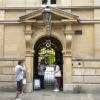 | William Bateman, Bishop of Norwich, to train clergymen in canon law after the Black Death | |
 |
Corpus Christi College Trumpington Street founded 1352 website |
 |  |
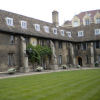 | St Benet's College | Cambridge guilds, Corpus Christi and the Blessed Virgin Mary |
1422 Henry VI became king | ||||||
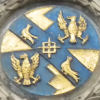 |
Magdalene College Magdalene Street founded 1428 website |
 |  Men  Women |
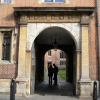 | Buckingham College | Thomas Audley, 1st Baron Audley of Walden |
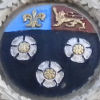 |
King's College Kings Parade founded 1441 website |
 |  |
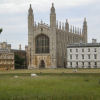 | Saint Nicholas | Henry VI |
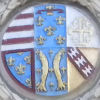 |
Queens' College Queens Lane founded 1448 website |
 |  |
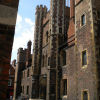 | St Bernard's College | Margaret of Anjou, wife of Henry VI |
1471 Henry VI died | ||||||
 |
St Catharine's College Trumpington Street founded 1473 website |
 |  |
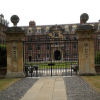 | Lady Katharine Hall | Robert Woodlark, Provost of King's College |
1485 Start of Tudors | ||||||
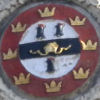 |
Jesus College Jesus Lane founded 1496 website |
 |  |
 | St Radegund's Nunnery | John Alcock, Bishop of Ely |
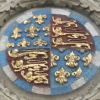 |
Christ's College St Andrews Street founded 1505 website |
 |  |
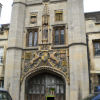 | God's House | Lady Margaret Beaufort, mother of Henry VII |
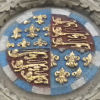 |
St John's College St Johns Street founded 1511 website |
 |  Lady Margaret |
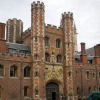 | St Johns Hospital | Lady Margaret Beaufort, mother of Henry VII |
1536-1541 The dissolution of the monasteries | ||||||
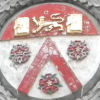 |
Trinity College Trinity Street founded 1546 website |
 |  1st & 3rd Trinity |
 | Kings Hall and Michaelhouse | Henry VIII |
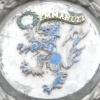 |
Emmanuel College St Andrews Street founded 1584 website |
 |  |
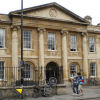 | Sir Walter Mildmay, Chancellor of the Exchequer to Elizabeth I | |
 |
Sidney Sussex College Sidney Street founded 1596 website |
 |  |
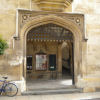 | Frances Sidney, Countess of Sussex, Lady of the Bedchamber to Elizabeth I | |
1603 End of Tudors | ||||||
 |
Downing College Regent Street founded 1800 website |
 |  |
 | will of Sir George Downing, 1st Baronet, who served both Cromwell and Charles II | |
1837 Victoria became queen | ||||||
 |
Fitzwilliam College Huntingdon Road founded 1869 website |
 |  |
Fitzwilliam House | ||
 |
Girton College Huntingdon Road founded 1869 website |
 |  |
|||
 |
Newnham College Sidgwick Avenue founded 1871 website |
 |  |
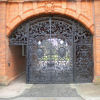 | ||
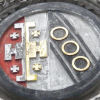 |
Selwyn College Grange Road founded 1882 website |
 |  |
|||
1914-1918 WWI 1939-1945 WWI | ||||||
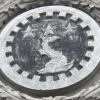 |
Murray Edwards College Huntingdon Road founded 1954 website |
 |  |
 | New Hall | |
 |
Churchill College Storey's Way founded 1960 website |
 |  |
|||
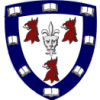 |
Homerton College Hills Road founded 1976 website |
 |  |
Teacher training college | ||
 |
Robinson College Grange Road founded 1979 website |
 |  |
|||
The point of arranging the colleges in order of foundation is to high-light the older colleges. Obviously not all buildings within a college date to its foundations, but some do. Peterhouse hall is the oldest hall in Cambridge; Corpus Christi Old Court is the oldest continually inhabited courtyard; Pembroke has the oldest surviving college entrance (although refaced in Victorian times); Queens has the oldest gatehouse; Clare has the oldest bridge. But other colleges have buildings older than they are. Trinity's gatehouse belongs to a previous college. The School of Pythagoras was a town house later absorbed within the grounds of St Johns College. Jesus took over St Rhadegund's Nunnery, including its chapel.
The foundation dates don't seem to be well-defined. I have taken the dates from the college index of the official Cambridge University website, which I hope is an authoritative source! But a postcard sold locally gives different dates, and once you start looking into it, you can understand why. Colleges were often formed in several steps. Magdalene started as a hostel in 1428, and did not become a college until 1542. They seem to take the earlier date as their foundation (although the postcard disagrees!) Trinity College was founded in 1546, from the merger of two existing colleges, Michaelhouse (1324) and King's Hall (1317). They take the later date as their foundation. Gonville and Caius was founded twice (explaining its double name), and they take the earlier date. Fitzwilliam College was formed out of the Non-Collegiate Students Board, founded in 1869, based at Fitzwilliam Hall, opposite the Fitzwilliam Museum in central Cambridge. The Non-Collegiate Students Board eventually became Fitzwilliam College in 1966 and moved to its present site in the north of the city. The earlier date is used in this case. There are several other cases where the foundation date seems to vary by a few years.
Jesus College is always known as that, but its corect name doesn't even include the name Jesus. It is "The College of the Blessed Virgin Mary, Saint John the Evangelist and the glorious Virgin Saint Radegund, near Cambridge".
| Founded | Name of college | Location | ||||
|---|---|---|---|---|---|---|
| 1885 | Hughes Hall | Mortimer Road | website | |||
| 1896 | St Edmund's College | Mount Pleasant | website | |||
| 1964 | Darwin College | Silver Street | website | |||
| 1965 | Clare Hall | Herschel Road | website | |||
| 1965 | Lucy Cavendish College | Lady Margaret Road | website | |||
| 1965 | Wolfson College | Barton Road | website |
These are not part of Cambridge University.
| Founded | Name of college | Location | |||
|---|---|---|---|---|---|
| 1877 | Ridley Hall | Ridley Hall Road | website | ||
| 1881 | Westcott House | Jesus Lane | website | ||
| 1921 | Wesley House | Jesus Lane | website |
There are two universities in Cambridge. The other one is Anglia Ruskin University, on East Road. The Cambridge School of Art was opened in 1858 by John Ruskin. In 1960 this became the Cambridgeshire College of Arts and Technology (CCAT). In 1989 CCAT merged with the Essex Institute of Higher Education to form the Anglia Higher Education College. The merged college became a polytechnic in 1991, using the name Anglia Polytechnic, and was then awarded university status in 1992. The name was changed to Anglia Ruskin University in 2005. Click here for their website.
There are other colleges in Cambridge. Cambridge Regional College is a further education establishment. There are sixth form colleges. There are a lot of language schools, teaching English as a foreign language, and they often call themselves colleges. There are other educational establishments as well.
© Jo Edkins 2010 - Return to Walks index